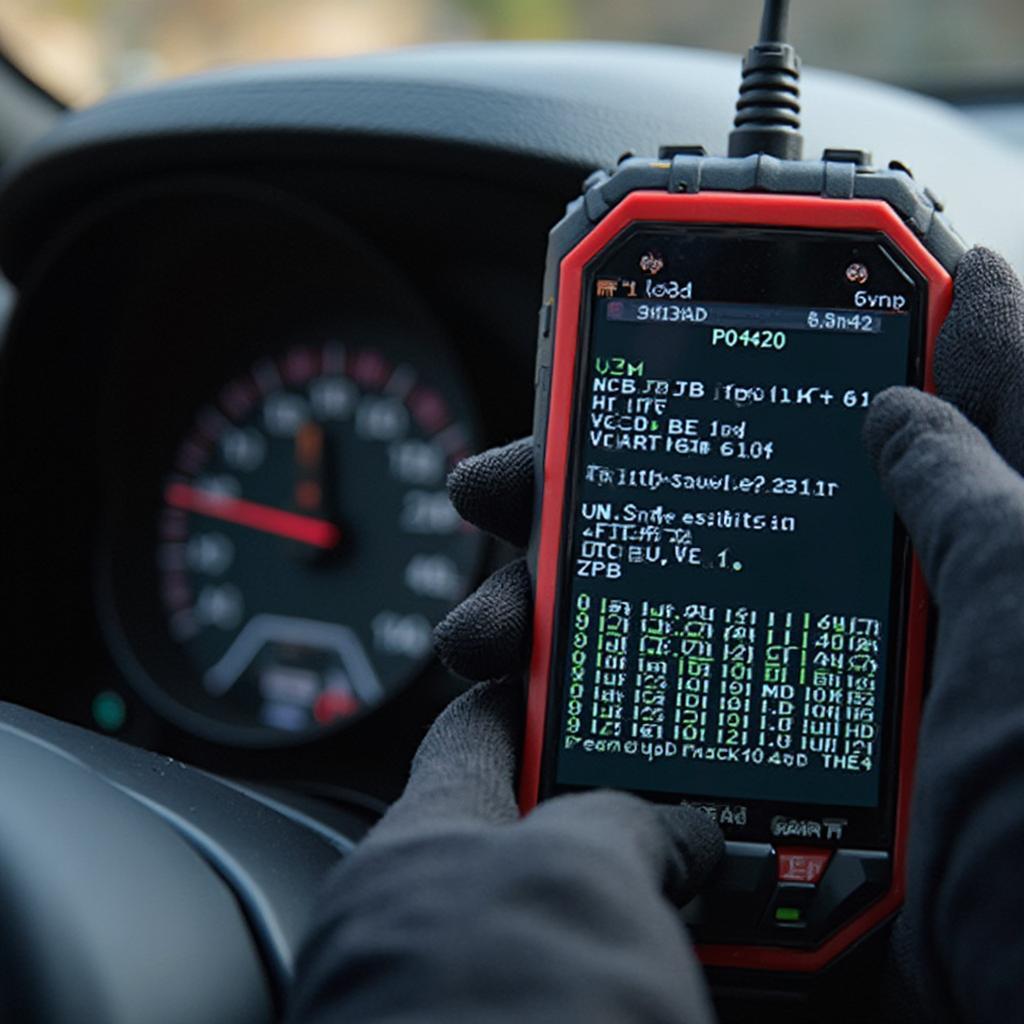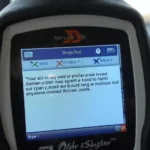The dreaded “Check Engine” light illuminates your dashboard, and your OBD2 scanner reveals the cryptic code P0420. What does it mean, and what should you do? This comprehensive guide will demystify the obd2 dash error code p0420, explaining its causes, symptoms, diagnostic procedures, and potential solutions. We’ll equip you with the knowledge to tackle this common issue and get your car back on the road.
Decoding the P0420 Code: Catalyst System Efficiency Below Threshold (Bank 1)
The P0420 code indicates a problem with your vehicle’s catalytic converter system, specifically “Bank 1.” For vehicles with a single exhaust system, there’s only one bank. In dual-exhaust systems (often found in V-shaped engines), Bank 1 typically refers to the side of the engine containing cylinder #1. The code essentially means the catalytic converter isn’t working efficiently enough to reduce harmful emissions.
What Causes the P0420 Code?
Several factors can trigger the P0420 code. A faulty catalytic converter is the most obvious culprit, but other issues can mimic its symptoms. These include:
- Faulty Oxygen Sensors: The oxygen sensors monitor the exhaust gases before and after the catalytic converter. Inaccurate readings from these sensors can trick the engine control module (ECM) into believing the converter is malfunctioning.
- Exhaust Leaks: Leaks in the exhaust system, especially before the catalytic converter, can alter the exhaust gas composition and trigger the code.
- Engine Misfires: Unburned fuel from engine misfires can overheat and damage the catalytic converter.
- Rich Fuel Mixture: A fuel mixture that’s too rich can overload the catalytic converter and reduce its efficiency.
- Damaged Catalytic Converter: Physical damage, internal blockage, or contamination can impair the converter’s function.
Recognizing the Symptoms of P0420
While the illuminated “Check Engine” light is the primary indicator, other symptoms might accompany the P0420 code:
- Decreased Fuel Economy: A failing catalytic converter can negatively impact fuel efficiency.
- Sluggish Engine Performance: Reduced catalytic converter efficiency can restrict exhaust flow, leading to sluggish acceleration.
- Rotten Egg Smell: A strong sulfur smell from the exhaust can indicate a malfunctioning catalytic converter.
- Failed Emissions Test: The P0420 code almost guarantees a failed emissions test.
Have you experienced any of these with your [codes for obd2 code reader]? Let’s delve into diagnosing the issue.
Diagnosing the P0420 Code
Proper diagnosis is crucial to avoid unnecessary repairs. Follow these steps:
- Retrieve the Code: Use an OBD2 scanner like the ones reviewed on OBDFree to confirm the P0420 code.
- Inspect for Exhaust Leaks: Visually inspect the exhaust system for any leaks or damage. Listen for hissing sounds, which could indicate a leak.
- Check Oxygen Sensor Readings: Use a scan tool to monitor the oxygen sensor readings before and after the catalytic converter. Compare the readings to manufacturer specifications.
- Test Catalytic Converter Efficiency: Perform a backpressure test to assess the catalytic converter’s flow restriction. This requires specialized equipment.
- Check for Engine Misfires: Diagnose and address any underlying engine misfire issues.
 OBD2 Scanner Displaying P0420 Code
OBD2 Scanner Displaying P0420 Code
“A thorough diagnostic process, starting with a quality [codes for obd2] scan tool, is paramount to pinpoint the root cause of the P0420 code,” advises Michael Stevens, ASE Certified Master Technician.
Fixing the P0420 Code
Once you’ve diagnosed the problem, the solution depends on the underlying cause:
- Replace Faulty Oxygen Sensors: If the oxygen sensors are malfunctioning, replace them with OEM or high-quality aftermarket sensors.
- Repair Exhaust Leaks: Repair any leaks in the exhaust system.
- Address Engine Misfires: Diagnose and fix any engine misfires, such as faulty spark plugs or ignition coils.
- Adjust Fuel Mixture: If the fuel mixture is too rich, address the underlying issue, which might involve a faulty fuel injector or a malfunctioning mass airflow sensor.
- Replace Catalytic Converter: If the catalytic converter itself is faulty, replacement is usually necessary.
You can find helpful resources and [performax can obd2 scan tool manual] on OBDFree to assist you.
Conclusion
The obd2 dash error code p0420 can be a frustrating issue, but understanding its meaning and causes empowers you to take control. By following the diagnostic procedures and solutions outlined in this guide, you can effectively address the problem and ensure your vehicle runs smoothly and efficiently. Regular maintenance and timely repairs can prevent future occurrences of the P0420 code. For further assistance, check our resources on [how to use cobra obd2] and [obd2 codes 2000 mitsubishi montero sport].
FAQ
- Can I drive with a P0420 code? While you can technically drive with a P0420 code, it’s not recommended. Ignoring the code can lead to further damage to the catalytic converter or other components.
- How much does it cost to fix a P0420 code? The cost varies depending on the underlying cause. Replacing oxygen sensors might cost a few hundred dollars, while a new catalytic converter can cost significantly more.
- Can a bad gas cap cause a P0420 code? While a bad gas cap can trigger other emissions-related codes, it’s unlikely to cause a P0420 code directly.
- How long does a catalytic converter last? Catalytic converters are designed to last the life of the vehicle, but they can fail prematurely due to various factors.
- Can I clean a catalytic converter? While some claim catalytic converter cleaners can work, they’re rarely effective in resolving a P0420 code caused by a genuinely faulty converter.
- Will a P0420 code clear itself? The code might clear itself temporarily if the underlying issue resolves itself, but it will likely return if the problem persists.
- Can I replace the catalytic converter myself? Replacing a catalytic converter can be a challenging DIY project, requiring specialized tools and knowledge.
Need more help with OBD2 codes? Explore our extensive library of articles and guides on OBDFree. You can also contact us for personalized support via WhatsApp: +1(641)206-8880, Email: [email protected] or visit our office at 789 Elm Street, San Francisco, CA 94102, USA. Our customer service team is available 24/7 to assist you.
